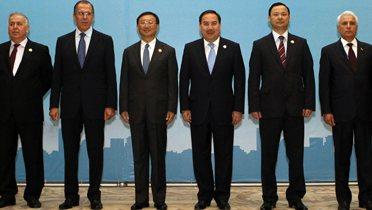INTRODUCTION
The U.S. military officers surveyed the foreign troops advancing with them toward the simulated terrorist stronghold. On the U.S. officers’ right were Russian special operations forces, with a few Central Asian personnel alongside, and to their left were their Chinese counterparts. Seeing the variety of foreign equipment in action at the joint security exercise was amazing and hearing the cacophony of languages over the communications lines was a bit jarring, but most striking of all to the U.S. officers was the patch on everyone’s arm—the Shanghai Cooperation Organization emblem.
Far-fetched? Perhaps not. The United States and the Shanghai Cooperation Organization (SCO) have common concerns in the region, including instability, counterterrorism and counternarcotics. The SCO also includes several countries that Washington likely fears could be the setting for future security hot spots. Washington’s persistent entanglement in Afghanistan further cements an interest in the SCO, which includes an Afghanistan Contact Group and guest attendance by President Hamid Karzai at SCO heads of state meetings. Furthermore, the SCO operates in the Eurasian region, where the United States finds itself heavily involved, yet geographically distant. And finally, all of the SCO countries, except China, have signed Partnership for Peace (PfP) framework documents with NATO and the Central Asian SCO members are past participants in PfP defense training and exercises, indications that the potential security benefits of cooperation already are recognized.
But perhaps no other regional organization is less consistently or objectively studied than the SCO. Foreign policy commentators have had varying takes on this organization and whether it is something the United States should care about or ignore, with the majority of the interest and research centered on the China-Russia relationship within the SCO and on the group’s security exercises. The basic facts about the organization are so laxly tracked that even prominent authors mistakenly include all five Central Asian states as official members (Turkmenistan, however, only attends meetings as an invited guest) or upgrade Afghanistan to an official observer state (again, as of now it is just a guest) in their best selling books. Even The New York Times, in a January 2011 article on Chinese inroads into Central Asia, gave an incorrect date for the establishment of the SCO’s precursor organization, the Shanghai Five (taking almost three weeks to correct its “editing error” from the originally posted “1966” to the correct “1996”).
Extreme views on the nature of this organization often accompany the lack of accuracy by many commentators. Some describe the SCO as a paper tiger while others suspiciously eye it as a counterweight to NATO. At the SCO’s five-year mark, a few authors questioned whether it was a nascent military alliance. In reality, however, the SCO’s direction and activities suggest it has evolved into something more in the middle of these positions in response to the changing global landscape over the last decade.
The SCO’s June 2011 summit will mark the tenth anniversary of the founding of the SCO. This milestone is a crucial time to examine the SCO’s development over the last decade and where it appears to be headed. The key questions of this paper are: Has the past decade been a lost one for the SCO, or has it made any progress as an effective organization? And, given uncertainties about a rising China, a reset Russia, and unstable regimes in the Eurasian region, are there reasons why the United States might consider the opportunities—and risks—of enhanced engagement with the SCO, a group which encompasses all of these challenges? This paper lays out potential next steps the United States could take to move a U.S.-SCO relationship forward if Washington chooses to do so.


